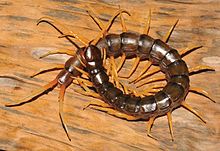Scolopendra cataracta
| Scolopendra cataracta | |
|---|---|

| |
| Scientific classification | |
| Domain: | Eukaryota |
| Kingdom: | Animalia |
| Phylum: | Arthropoda |
| Subphylum: | Myriapoda |
| Class: | Chilopoda |
| Order: | Scolopendromorpha |
| Family: | Scolopendridae |
| Genus: | Scolopendra |
| Species: | S. cataracta
|
| Binomial name | |
| Scolopendra cataracta Siriwut, Edgecombe & Panha, 2016
| |
Scolopendra cataracta is a species of centipede in the family Scolopendridae.[1][2] It is the first known amphibious centipede, growing to up to 20 centimetres (7.9 in) in length.[2][3]
Description
Scolopendra cataracta is a giant centipede, growing to around 200 mm (7.9 in) in length; it has long legs and a greenish-black colour.
The species is apparently endemic to Southeast Asia, with specimens from Laos, Thailand, and Vietnam.[2]
References
- ^ Bonato L.; et al. (2016). "Scolopendra cataracta Siriwut, Edgecombe, Panha, 2016". ChiloBase 2.0 – A World Catalogue of Centipedes (Chilopoda). Retrieved 27 November 2020.
- ^ a b c d e f Bates, M. (26 June 2016). "'Horrific' First Amphibious Centipede Discovered". National Geographic. Archived from the original on June 26, 2016. Retrieved 1 July 2016.
- ^ a b c Holmes, O. (1 July 2016). "Giant swimming, venomous centipede discovered by accident in world-first". The Guardian. Retrieved 1 July 2016.
- ^ "Dr George Beccaloni – Curator, Orthopteroidea and Wallace Collection". Natural History Museum, London. Retrieved 1 July 2016.
- ^ Nijhuis, Michelle (3 July 2016). "It's always a joy to discover a new species. But there is a downside..." The Guardian. Retrieved 3 July 2016.
- PMID 27408540.
